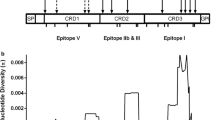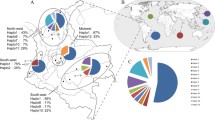Abstract
Background
The 19 kDa C-terminal region of the merozoite surface protein 1 (MSP119) has been suggested as candidate for part of a subunit vaccine against malaria. A major concern in vaccine development is the polymorphism observed in different plasmodial strains. The present study examined the extension and immunological relevance of the allelic polymorphism of the MSP119 from Plasmodium vivax, a major human malaria parasite.
Materials and Methods
We cloned and sequenced 88 gene fragments representing the MSP119 from 28 Brazilian isolates of P. vivax. Subsequently, we evaluated the reactivity of rabbit polyclonal antibodies, a monoclonal antibody, and a panel of 80 human sera to bacterial and yeast recombinant proteins representing the two allelic forms of P. vivax MSP119 described thus far.
Results
We observed that DNA sequences encoding MSP119 were not as variable as the equivalent region of other species of Plasmodium, being conserved among Brazilian isolates of P. vivax. Also, we found that antibodies are directed mainly to conserved epitopes present in both allelic forms of the protein.
Conclusions
Our findings suggest that the use of MSP119 as part of a subunit vaccine against P. vivax might be greatly facilitated by the limited genetic polymorphism and predominant recognition of conserved epitopes by antibodies.





Similar content being viewed by others
References
Good MF, Kaslow DC, Miller LH. (1998) Pathways and strategies for developing a malaria blood-stage vaccine. Annu. Rev. Immunol. 16: 57–87.
Blackman MJ, Heidrich HG, Donachie S, McBride JS, Holder AA. (1990). A single fragment of a malaria merozoite surface protein remains on the parasite during red blood cell invasion and is the target of invasion-inhibiting antibodies. J. Exp. Med. 172: 379–382.
Pirson PJ, Perkins ME. (1985) Characterization with monoclonal antibodies of a surface antigen of Plasmodium falciparum merozoites. J. Immunol. 134: 1946–1951.
Chappel JA, Holder AA. (1993) Monoclonal antibodies that inhibit Plasmodium falciparum invasion in vitro recognise the first growth factor-like domain of merozoite surface protein-1. Mol. Biochem. Parasitol. 60: 303–312.
Chang SP, Gibson HL, Lee NC, Barr PJ, Hui GS. (1992) A carboxyl-terminal fragment of Plasmodium falciparum gp 195 expressed by a recombinant baculovirus induces antibodies that completely inhibit parasite growth. J. Immunol. 149: 548–555.
Burns JM, Parke LA, Daly TM, Cavacini LA, Weidanz WP, Long CA. (1989) A protective monoclonal antibody recognizes a variant-specific epitope in the precursor of the major merozoite surface antigen of the rodent malarial parasite Plasmodium yoelii. J. Immunol 142: 2835–2840.
Daly TM, Long CA. (1995) The humoral immune response to a carboxyl-terminal region of the merozoite surface protein-1 plays a predominant role in controlling blood-stage infection in rodent malaria. J. Immunol 155: 236–243.
Daly TM, Long CA. (1993) A recombinant 15-kilodalton carboxyl-terminal fragment of Plasmodium yoelii 17XL merozoite surface protein-1 induces a protective immune response in mice. Infect. Immun. 61: 2462–2467.
Ling IT, Ogun SA, Holder AA. (1994) Immunisation against malaria with a recombinant protein. Parasite Immunol. 16: 63–67.
Kumar S, Yadava A, Keister DB, et al. (1995) Immunogenicity and in vivo efficacy of recombinant Plasmodium falciparum merozoite surface protein-1 in Aotus monkeys. Mol Med. 1: 325–332.
Tian JH, Kumar S, Kaslow DC, Miller LH. (1997) Comparison of protection induced by immunization with recombinant proteins from different regions of merozoite surface protein 1 of Plasmodium yoelii. Infect. Immun. 65: 3032–3036.
Perera KLRL, Handunnetti SM, Holm I, Longacre S, Mendis K. (1998) Baculovirus merozoite surface protein 1 C-terminal recombinant antigens are highly protective in a natural primate model for human Plasmodium vivax malaria. Infect. Immun. 66: 1500–1506.
Yang C, Collins WE, Sullivan JS, Kaslow DC, Xiao L, Lal AA. (1999) Partial protection against Plasmodium vivax blood-stage infection in Saimiri monkeys by immunization with a recombinant C-terminal fragment of merozoite surface protein 1 in block copolymer adjuvant. Infect. Immun. 67: 342–349.
Ling IT, Ogun SA, Holder AA. (1995) The combined epidermal growth factor-like modules of Plasmodium yoelii merozoite surface protein-1 are required for a protective immune response to the parasite. Parasite Immunol 17: 425–433.
Daly TM, Burns JM, Long CA. (1992) Comparison of the carboxy-terminal, cysteine-rich domain of the merozoite surface protein-1 from several strains of Plasmodium yoelii. Mol. Biochem. Parasitol 52: 279–282.
Rénia L, Ling IT, Marussig M, Miltgen F, Holder AA, Mazier D. (1997) Immunization with a recombinant C-terminal fragment of Plasmodium yoelii merozoite surface protein 1 protects mice against homologous but not heterologous P. yoelii sporozoite challenge. Infect. Immun. 65: 4419–4423.
Tanabe K, MacKay M, Goman M, Scaife JG. (1987) Allelic dimorphism of a surface antigen gene of the malaria parasite. J. Mol. Biol. 134: 1946–1951.
Miller LH, Roberts T, Shahabuddin M, McCutchan T. (1993) Analysis of the sequence diversity in the Plasmodium falciparum merozoite surface protein-1. Mol Biochem. Parasitol. 59: 1–14.
Qari SH, Shi YP, Goldman IF, Nahlen BL, Tibayrenc M, Lal AA. (1998) Predicted and observed alleles of Plasmodium falciparum merozoite surface protein-1 (MSP-1), a potential malaria vaccine antigen. Mol. Biochem. Parasitol. 92: 241–252.
Wilson CF, Anand R, Clark JT, McBride JS. (1987) Topography of epitopes on a polymorphic antigen of Plasmodium falciparum determined by the binding of monoclonal antibodies in a two-site radioimmunoassay. Parasite Immunol 9: 737–746.
McBride JS, Heidrich HG. (1987) Fragments of the polymorphic Mr 185,000 glycoprotein from the surface of isolated Plasmodium falciparum merozoites form antigenic complex. Mol. Biochem. Parasitol. 23: 71–84.
Cooper JA, Cooper LT, Saul AJ. (1992) Mapping of the region predominantly recognized by antibodies to Plasmodium falciparum surface antigen MSA 1. Mol. Biochem. Parasitol. 51: 301–312.
Udhayakumar V, Anyona D, Kariuki S, et al. (1995) Identification of T and B cell epitopes recognized by humans in the C-terminal 42-kDa domain of Plasmodium falciparum merozoite surface protein (MSP)-l. J. Immunol. 154: 6022–6030.
Shi YP, Sayed U, Qari SH, et al. (1996) Natural immune response to the C-terminal 19-kilodalton domain of Plasmodium falciparum merozoite surface protein 1. Infect. Immun. 64: 2716–2723.
Pasay MC, Cheng Q, Rzepczyk C, Saul A. (1995) Dimorphism of the C terminus of the Plasmodium vivax merozoite surface protein 1. Mol Biochem. Parasitol. 70: 217–219.
Soares IS, Levitus G, Souza JM, del Portillo HA, Rodrigues MM. (1997) Acquired immune responses to the N- and C-terminal regions of Plasmodium vivax merozoite surface protein 1 in individuals exposed to malaria. Infect. Immun. 65: 1606–1614.
Soares IS, Cunha MG, Silva MN, Souza JM, del Portillo HA, Rodrigues MM. (1999) Longevity of the naturally acquired antibody responses to the N- and C-terminal regions of Plasmodium vivax MSP1. Am. J. Trop. Med. Hyg. 60: 357–363.
Fraser T, Michon P, Barnwell JW, et al. (1997) Expression and serologic activity of a soluble recombinant Plasmodium vivax Duffy binding protein. Infect. Immun. 65: 2772–2777.
Longacre S, Mendis KN, David P. (1994) Plasmodium vivax merozoite surface protein 1 recombinant proteins in baculovirus. Mol Biochem. Parasitol. 64: 191–205.
Holm I, Nato F, Mendis KN, Longacre S. (1997) Characterization of the C-terminal merozoite surface protein 1 baculovirus recombinant proteins from Plasmodium vivax and Plasmodium cynomolgi as recognized by natural anti-parasite immune response. Mol. Biochem. Parasitol. 89: 313–319.
Barnwell JW, Galinski MR, DeSimone SG, Perler F, Ingravallo P. (1999) Plasmodium vivax, P. cynomolgi, P. knowlesi: identification of homologue proteins associated with the surface of merozoites. Exp. Parasitol. 91: 238–249.
del Portillo HA, Parrillo LB, Camargo AA, Levitt A. (1993) Amplification of single-copy genes of Plasmodium vivax from two drops of peripheral blood of infected patients. J. Protozool. Res. 3: 20–24.
Porto M, Ferreira MU, Camargo LMA, Premawansa S, del Portillo HA. (1992) Second form in a segment of the merozoite surface protein 1 gene of Plasmodium vivax among isolates from Rondônia (Brazil). Mol. Biochem. Parasitol. 54:121–124.
Mitchell DA, Marshall TK, Deschenes RI. (1993) Vectors for the inducible overexpression of glutathione S-transferase fusion proteins in yeast. Yeast 9: 715–723.
Devey ME, Bleasdale K, Lee S, Rath S. (1988) Determination of the functional affinity of IgG1 and IgG4 antibodies to tetanus toxoid by isotype-specific solid-phase assays. J. Immunol. Methods 106: 119–125.
Camargo LMA, Dal Colletto GMD, Ferreira MU, et al. (1996) Hypoendemic malaria in Rondonia (Brazil, western Amazon region): seasonal variation and risk groups in an urban locality. Am. J. Trop. Med. Hyg. 55: 32–38.
del Portillo HA, Longacre S, Khouri E, David P. (1991) Primary structure of the merozoite surface antigen 1 of Plasmodium vivax reveals sequences conserved between different Plasmodium species. Proc. Natl. Acad. Sci. U.SA. 88: 4030–4034.
Gibson HL, Tucker JE, Kaslow DC, et al. (1992) Structure and expression of the gene for Pv200, a major blood-stage surface antigen of Plasmodium vivax. Mol. Biochem. Parasitol. 50: 325–334.
Kirchgatter K, del Portillo HA. (1998) Molecular analysis of Plasmodium vivax relapses using the MSP1 molecule as a genetic marker. J. Infect. Dis. 177: 511–515.
Egan AF, Chappel JA, Burghaus PA, et al. (1995) Serum antibodies from malaria-exposed people recognize conserved epitopes formed by the two epidermal growth factor motifs of MSP119, the carboxy-terminal fragment of the major merozoite surface protein of Plasmodium falciparum. Infect. Immun. 63: 456–466.
Kaslow DC, Hui G, Kumar S. (1994) Expression and antigenicity of Plasmodium falciparum merozoite surface protein 1 (MSP19) variants in Saccharomyces cerevisiae. Mol. Biochem. Parasitol. 63: 283–289.
Hui GSN, Nikaido C, Hashiro C, Kaslow DC, Collins WE. (1996) Dominance of conserved B-cell epitopes of the Plasmodium falciparum merozoite surface protein, MSP1, in blood-stage infections of naive Aotus monkeys. Infect. Immun. 64: 1502–1509.
Koup R. (1994) Virus escape from CTL. J. Exp. Med. 180: 779–782.
Couillin I, Culman-Penciolelli B, Gomard E, Levy J-P, Guillet J-G, Saragosti S. (1994) Impaired CTL recognition due to genetic variations in the main immunogenic region of HTV-1 nef protein. J. Exp. Med. 180: 1129–1134.
de Campos Lima P-O, Levistky V, Brooks J, et al. (1994) T cell response and virus evolution: loss of HLA-A11-restricted CTL epitopes in Epstein-Barr virus isolates from highly All-positive populations by selective mutations at the anchor sequence. J. Exp. Med. 179: 1297–1305.
Udhayakumar V, Ongecha JM, Shi YP, et al. (1997) Cytotoxic T cell reactivity and HLA-B35 binding of the variant Plasmodium falciparum circunsporozoite protein CD8+ CTL epitope in naturally exposed Kenian adults. Eur. J. Immunol. 27: 1952–1957.
Pircher H, Moskophidis D, Roher U, Burki K, Hengartner H, Zinkernagel DM. (1990) Viral escape by selection of cytotoxic T-cell resistant virus variants in vivo. Nature 34: 629–633.
Bertoletti A, Sette A, Chisari FV, et al. (1993) Natural variants of cytotoxic epitopes are T-cell receptor antagonists for antiviral cytotoxic T cells. Nature 364: 158–160.
Gilbert SC, Plebanski M, Gupta S, et al. (1998) Association of malaria parasite, population structure, HLA, and immunological antagonism. Science 279: 1173–1177.
Acknowledgments
The authors are indebted to Dr. Hernando Del Portillo, University of São Paulo, for providing the plasmid ICB10. This work was supported by grants from FAPESP, PADCT, CNPq, PRONEX, and FINEP to M.M.R. M.U.F. and M.M.R. are the recipients of fellowships from CNPq. I.S.S. is a post-doctoral fellow of FAPESP.
Author information
Authors and Affiliations
Corresponding author
Rights and permissions
About this article
Cite this article
Soares, I.S., Barnwell, J.W., Ferreira, M.U. et al. A Plasmodium vivax Vaccine Candidate Displays Limited Allele Polymorphism, Which Does Not Restrict Recognition by Antibodies. Mol Med 5, 459–470 (1999). https://doi.org/10.1007/BF03403539
Accepted:
Published:
Issue Date:
DOI: https://doi.org/10.1007/BF03403539




